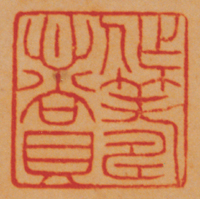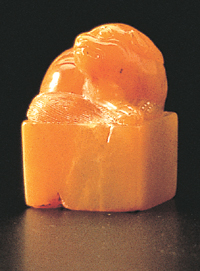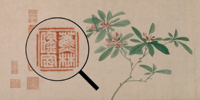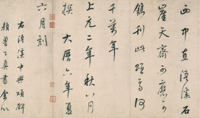Serena Chu
Former Assistant Curator II (Xubaizhai), Hong Kong Museum of Art
2008
 |
 |
|
| Fig.1 | Fig.2 |
 |
| Fig.3 |
 |
| Fig.4 |
When you look at a Chinese painting or calligraphy work, do you ever pay any attention to the vermilion impression of a seal that it bears? Have you ever wondered why the seal has been stamped there? The use of seals as a means of certification or identification actually dates back to the Warring States period (465-221BC) in ancient China, but it was not until the Tang dynasty (AD618-907) that they were first applied to paintings and calligraphy, and they only became truly popular in this field in the Song dynasty (AD960-1279). Today, the impressing of a seal on a finished work of art is considered a unique characteristic of Chinese painting and calligraphy.
Seals stamped on paintings and calligraphy works can basically be divided into two types. One is the artist's seal, representing the artist's signature, and the other is the seal of the connoisseur or collector, which serves as a record of viewing or ownership of the work. Both types feature different kinds of inscriptions, and they can thus be further classified into name seals, studio seals, motto seals, diagram seals and so on. Seal impressions represent an important tool for authenticating Chinese paintings and calligraphy works: the clues they provide can tell us who the artist was and which collectors have owned the work. However, we cannot always draw definite conclusions from these seal impressions alone, as it is not unknown for faked seal impressions to be found on genuine works of art or for faked works to bear genuine seal impressions.
In addition to studying the shape, the lettering style and the colour of the seal impression as well as where it is positioned on the work, we also have to know something about how the owner of a seal would commonly use it in practice. Indeed, most artists, collectors and connoisseurs would have more than one seal. For example, Mr Low Chuck-tiew (1911-1993), owner of the Xubaizhai Collection, had over 50 seals each bearing a different inscription, such as "viewed by the owner of Xubaizhai" or "heartily appreciated by Chucktiew" (fig. 1), which it is thought he used to distinguish how fond he was of a particular work.
The seals of renowned connoisseurs can be compared to today's "Quality Assurance" systems. The famous connoisseur and collector Liang Qingbiao (1620-1690, also known as Jiaolin) of the Qing dynasty(1644-1911) used to stamp a square seal bearing four incised characters "endorsed by Jiaolin" (fig. 2) on the paintings he had viewed and collected as a kind of certificate of quality. This seal impression can be found on Flower by Chen Chun (1483-1544) (fig. 3), a handscroll in the Xubaizhai Collection, which suggests that Liang also once owned this scroll. Coincidentally, both the scroll and the seal can be found in the Hong Kong Museum of Art and its branch, the Flagstaff House Museum of Tea Ware, thanks to the generous donations of two philanthropic collectors, Mr Low Chuck-tiew and Dr K. S. Lo (1910-1995), in 1989 and 1994 respectively.
Several other functions are also attributed to seal impressions: they can enhance the balance of the composition and they can keep the work intact. Moreover, long handscrolls, which usually comprise several sheets of paper or silk, would be stamped in the margins with "indent seal impressions" (qifeng yin) (fig. 4) to prevent the scroll from being cut up into several pieces that could then be remounted and sold separately.
Knowing more about what seals are used for can enhance our appreciation of a work of art. Seals are also an art form in themselves. So the next time you are viewing a Chinese painting or calligraphy work, why not spend a bit of time thinking about the seal that you find there? As you can see, these vermilion impressions have their own story to tell!



